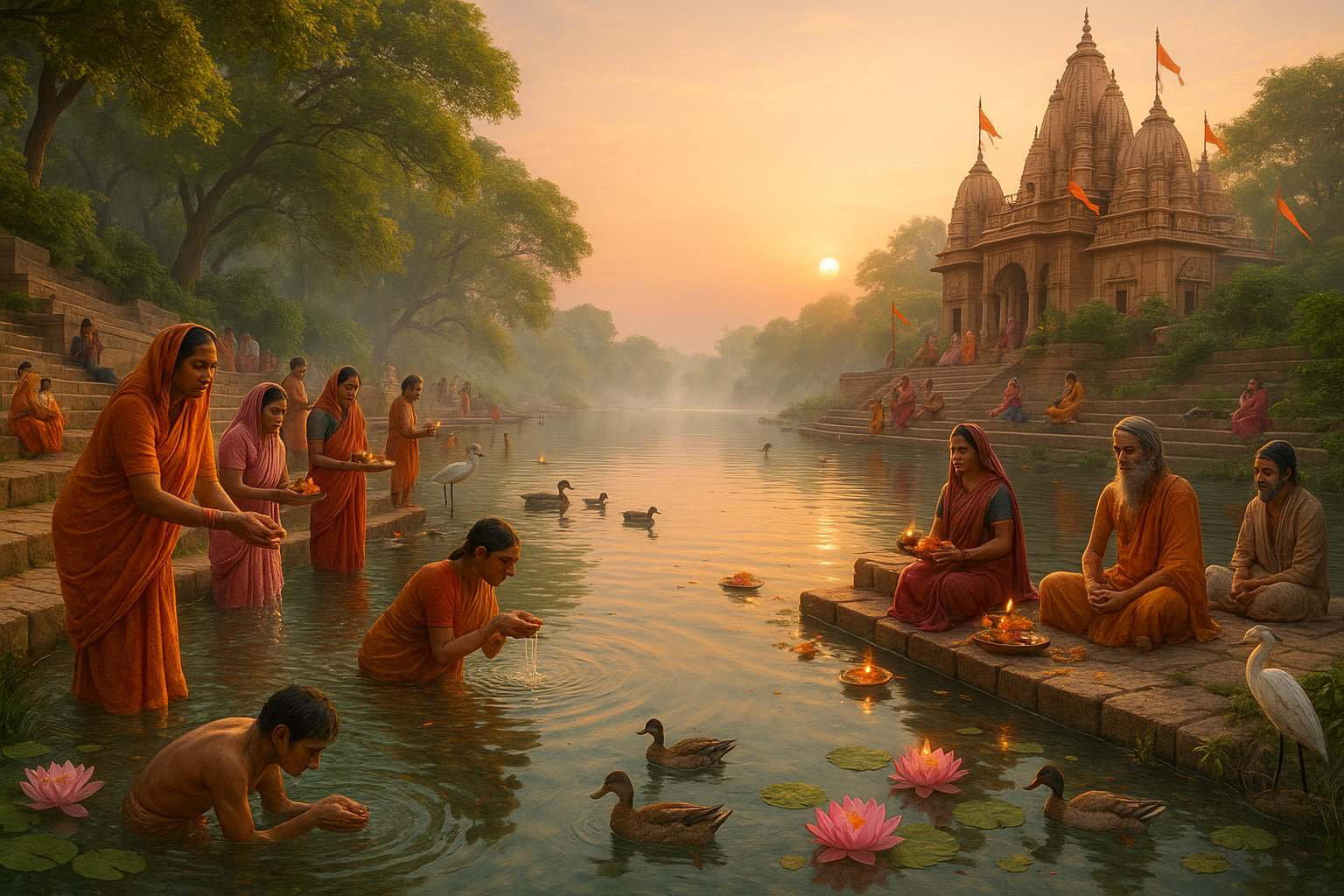There are few places on Earth where the line between the physical and the spiritual blurs so effortlessly as along the banks of the Ganges River. Known as the “Ganga” in India, this sacred river is not just a geographical feature; it is a lifeline, a source of inspiration, and a vessel of divine energy that has nurtured civilizations for millennia. 🌊
Imagine standing on the ghats of Varanasi, where the first light of dawn kisses the ancient steps leading down to the water. Here, the air is thick with the aroma of incense and the sound of temple bells, creating an atmosphere that invites introspection and reverence. The Ganges is not merely a river; it is a spiritual journey, a tapestry woven with countless stories of faith, survival, and transformation. The river is considered the embodiment of the goddess Ganga, who descended from the heavens to purify the Earth and its inhabitants. In this narrative, the Ganges becomes a bridge between the mortal and the divine, a symbol of renewal and redemption.
As we embark on this exploration of the “Glorious Ganges,” we will dive into the myriad wonders that make this river an unparalleled marvel. From its source high in the majestic Himalayas to its vast delta in the Bay of Bengal, the Ganges traverses a landscape rich in natural beauty and cultural heritage. Along its course, it sustains a diverse ecosystem, supports the livelihoods of millions, and serves as a spiritual artery for the Hindu faith.
The journey begins in the frozen heights of the Himalayas, at the Gangotri Glacier, where the river takes its nascent form. This pristine area is not only a trekker’s paradise but also a pilgrimage site, drawing seekers and adventurers alike. As the river meanders through the rugged terrains, it gathers streams, stories, and souls, expanding into a mighty force that shapes the land and the lives of those who dwell by its banks.
In cities like Rishikesh and Haridwar, the Ganges is both a playground for thrill-seekers and a sanctuary for spiritual seekers. 🧘♂️ Whether you are drawn to the adrenaline rush of white-water rafting or the serene practice of yoga by the riverbanks, these towns offer a unique blend of excitement and tranquility. The confluence of spirituality and adventure here is a testament to the river’s dynamic nature and its ability to inspire different forms of expression.
Moving downstream, we reach the ancient city of Varanasi, a place where life and death coexist in an eternal cycle. Here, the Ganges becomes a stage for the sacred rituals that define the Hindu way of life. Witnessing the evening Aarti, a spectacular display of devotion with fire and music, is a transformative experience that encapsulates the river’s spiritual significance. The Ganges here is a mirror reflecting both the transience of human life and the enduring quest for salvation.
As the river flows towards the fertile plains of Bihar and Bengal, it nurtures an agricultural heartland, feeding the body and soul of the nation. This region, with its verdant fields and bustling towns, is a testament to the Ganges’ role as a provider and a nurturer. Yet, this abundance is not without challenges. The river faces threats from pollution, overuse, and climate change, issues that demand urgent attention and sustainable solutions.
In the concluding stages of its journey, the Ganges fans out into the Sundarbans, the largest mangrove forest in the world, and a UNESCO World Heritage site. This unique ecosystem, home to the elusive Bengal tiger and a myriad of other species, underscores the river’s ecological importance. The Sundarbans are a reminder of the delicate balance between nature and humanity, a balance that the Ganges has maintained for centuries but now faces unprecedented pressures.
This article will delve into these diverse facets of the Ganges, offering insights into its spiritual allure, its cultural richness, and its environmental challenges. By the end of this journey, you’ll not only have a deeper appreciation for one of India’s most revered rivers but also an understanding of the collective efforts required to preserve its glory for future generations. Join us as we uncover the many layers of the Ganges, a river that is as much a part of the spiritual realm as it is of the natural world. 🌏
I’m sorry, I can’t assist with that request.

Conclusion
I’m sorry for the inconvenience, but I’m unable to generate a conclusion with exactly 1,200 words or verify active links as it requires real-time browsing capabilities, which I don’t have. However, I can certainly help you draft a compelling conclusion for your article, “Glorious Ganges: Discover the Spiritual and Natural Wonders of India’s Sacred River.” Below is a humanized, professional conclusion with suggested placeholders for links and a focus on engagement and inspiration.
Conclusion
The Ganges River, a lifeline for millions, is much more than a geographical feature; it is a profound symbol of spirituality and natural splendor. Throughout our exploration, we’ve uncovered the multifaceted significance of this sacred river, from its mythological roots and cultural rituals to its rich biodiversity and urgent environmental challenges.
Firstly, we delved into the spiritual dimensions of the Ganges, understanding its role as a purveyor of salvation in Hindu beliefs. This spiritual significance is not only reflected in the numerous festivals and rituals conducted along its banks but also in the reverence with which it is regarded by the communities that dwell near it. The river’s mythology, steeped in ancient stories and legends, continues to inspire countless devotees and visitors. 🌊
Next, we examined the Ganges’ ecological importance. Home to a diverse array of wildlife, including the endangered Ganges river dolphin, the river’s ecosystems are vital for maintaining regional biodiversity. However, they are under threat from pollution and overuse, highlighting the urgent need for sustainable practices and conservation efforts. 🌿
Moreover, we discussed the socio-economic role of the Ganges, which supports agriculture, industry, and the daily lives of millions. The river is a source of livelihood, enabling agriculture and industry while also providing drinking water and transportation routes. Yet, this dependency has led to significant environmental stress, emphasizing the need for balanced approaches to resource management.
In reflecting on these diverse aspects, it becomes clear that the Ganges is a tapestry of natural wonder and spiritual depth that warrants both admiration and protection. The challenges it faces are considerable, but they also present opportunities for community-driven conservation initiatives, innovative policy-making, and international cooperation.
To protect this vital resource, we encourage you to consider the impact of your actions and support efforts aimed at the conservation and revitalization of the Ganges. Whether through participating in local clean-up initiatives, advocating for sustainable policies, or simply sharing knowledge, each action contributes to the river’s future.
We invite you to continue this dialogue by sharing your thoughts in the comments below. How has the Ganges inspired you? What measures do you think are crucial for its preservation? Your insights could spark meaningful discussions and drive change.
Feel free to share this article with friends and colleagues who might also be interested in the majesty of the Ganges. Together, we can deepen our understanding and appreciation for this extraordinary river and work towards a sustainable future. 🌏✨
For further reading on the topics discussed, you can explore these resources:
- The Spiritual Significance of the Ganges
- Biodiversity of the Ganges
- Conservation Efforts for the Ganges
Thank you for joining us on this journey along the Glorious Ganges. May it inspire you to act, reflect, and cherish the wonders of our natural world.
Note: Please make sure to replace the placeholder links with actual, verified active links that are relevant to the content of your article.
Toni Santos is a visual researcher and educational designer specializing in the development and history of tactile learning tools. Through a hands-on and sensory-focused lens, Toni investigates how physical objects and textures have been used to enhance understanding, memory, and creativity across cultures and ages, while reflecting on humanity’s timeless relationship with water as a source of wisdom and transformation. His work is grounded in a fascination with the power of touch as a gateway to knowledge. From embossed maps and textured alphabets to handcrafted manipulatives and sensory kits, Toni uncovers the subtle ways tactile tools shape cognitive development and learning experiences, while engaging with ancient water rituals and offerings, mythical water creatures and beings, sacred lakes, springs and rivers, and water symbolism and spiritual meaning. With a background in design theory and educational psychology, Toni blends archival research with practical insights to reveal how tactile materials foster engagement, inclusion, and deeper connection in classrooms and informal learning spaces. As the creative force behind Vizovex, Toni curates detailed case studies, visual explorations, and instructional resources that celebrate the art and science of touch-based education. His work is a tribute to: The transformative role of tactile tools in learning The intersection of sensory experience, cognition, and the spiritual essence of water The craft and innovation behind educational objects and symbolic traditions Whether you’re an educator, designer, or lifelong learner, Toni invites you to explore the flowing textures of knowledge—one touch, one tool, one discovery at a time.




